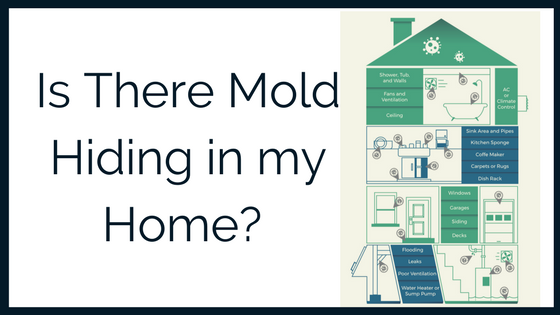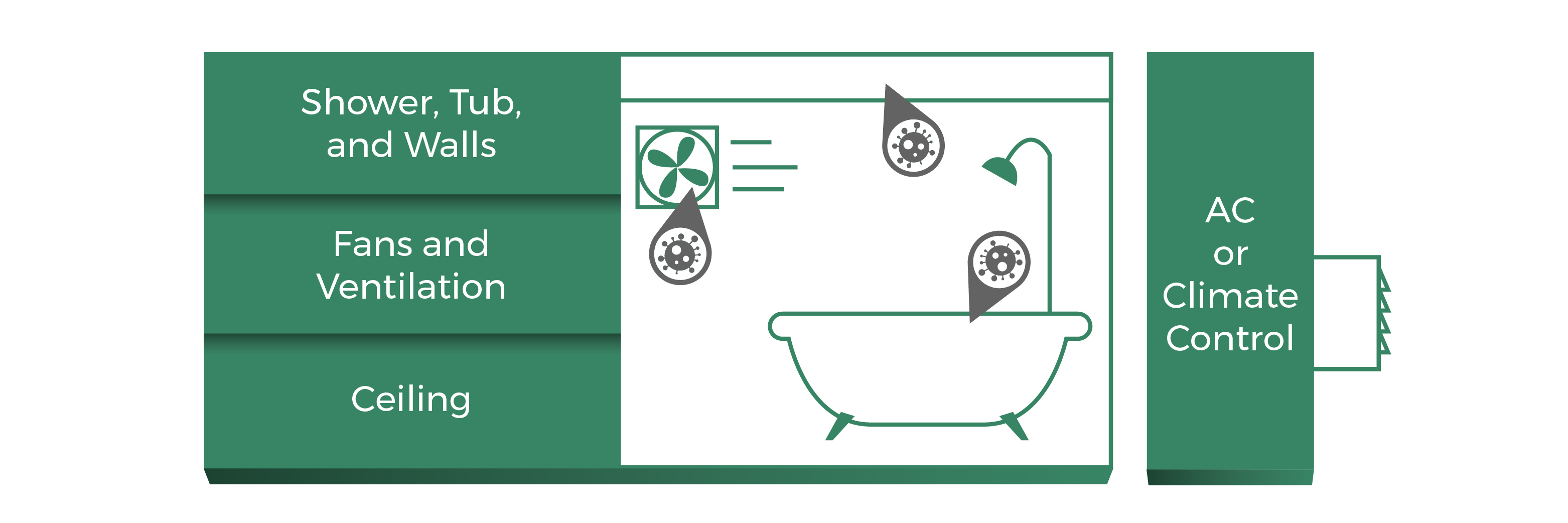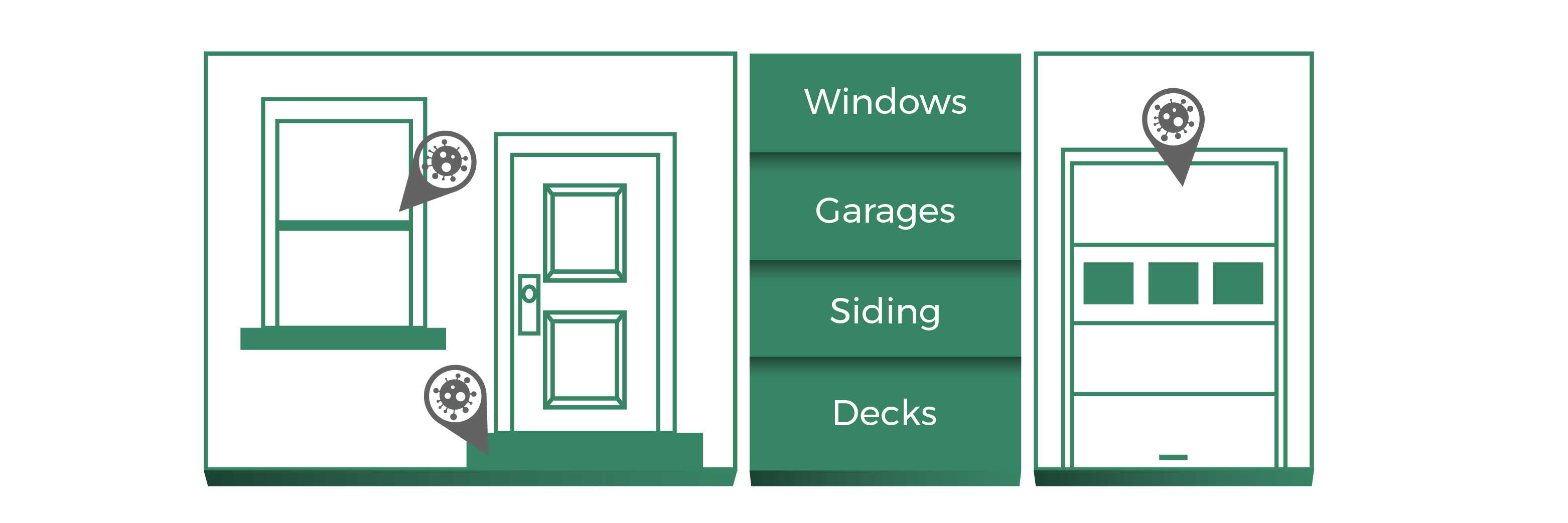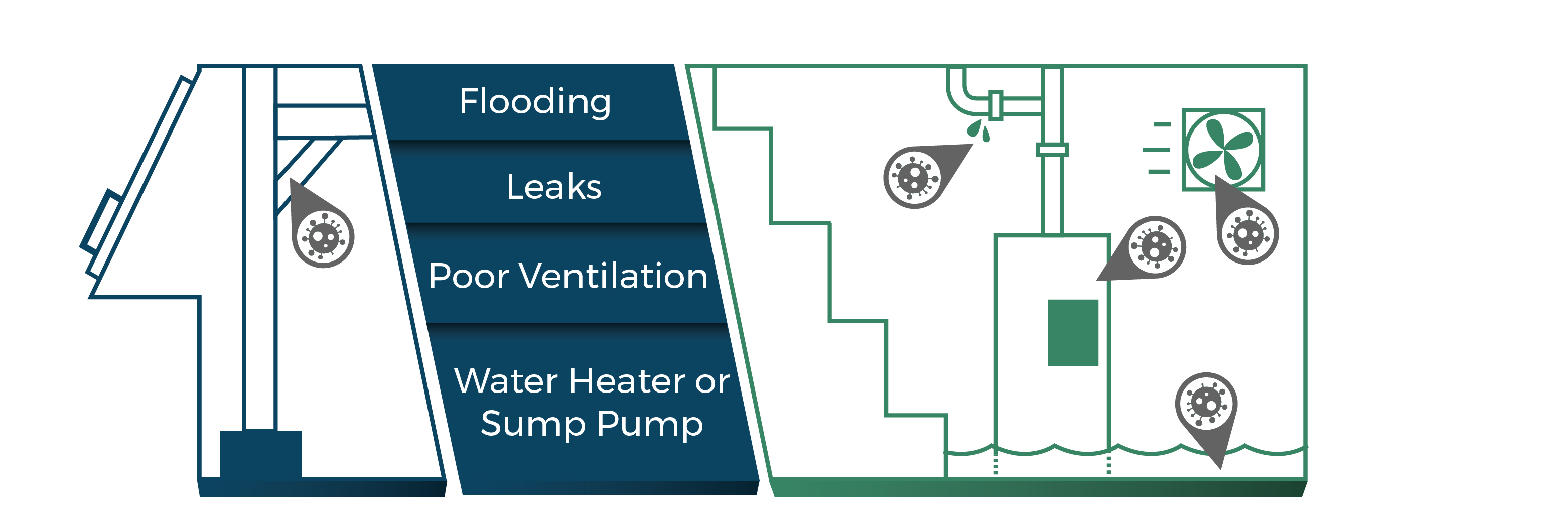
For homeowners and renters alike, no one likes finding mold in their home. While you can easily spot mold in the main areas of your house, many less obvious areas can also attract mold. Areas such as basements, crawl spaces, and cabinets that are less frequently used can attract mold that may grow unchecked for long periods of time. To help you avoid that, we’ve covered some common areas in your home in which you may find mold, how to prevent it, and what to do when you do find it.

Mold in your attic
Why do attics attract mold?
Attic mold is almost always the result of high humidity in the attic space. This high humidity causes condensation on the cold portions of the roofing materials (plywood or OSB) and results in mold growth on these surfaces. Attics should be designed with proper ventilation in mind. This would usually include low vents (soffit vents, bird blocks, etc.) and high vents (roof vents, ridge cap vents, etc.). Current code in Washington State requires one square foot of ventilation per 300 square feet of attic footprint. This is a general rule, but a qualified inspector should evaluate the type, location, and airflow through the individual vents to determine exactly what has caused the deficiency that led to the attic mold growth. A neutral unbiased attic mold inspection will give you the information you need to find out exactly what the next step should be.
What does an attic mold inspection include?
Before even considering attic mold remediation, be sure to identify and document the source of the moisture and make a plan to resolve the underlying conditions. Only qualified professionals with experience in building science and building diagnostics can do this.

Mold in Your Bathroom
Where water is present, mold can grow. Unfortunately, that’s why bathrooms are a common area for mold. Though mold in bathrooms doesn’t typically have extreme consequences, it can be a big trigger for allergies and damage your home over time.
Where you might find mold in your bathroom
Mold might grow in or on the:
- Shower, tub, and surrounding walls: Mold and mildew between your shower tiles is common as a result of their frequent exposure to water.
- Fans: Your bathroom fan is supposed to prevent mold in your home. However, if a vent in this fan is leaking, which sometimes happens with older or highly used fans, they can do more harm than good.
- Ceiling: As you probably learned in elementary school science, hot air rises. Humid air in bathrooms can linger on your ceiling, creating a place for mold to grow.
How to prevent mold growth in your bathroom
To prevent mold growth:
- Frequently inspect your bathroom walls, tiles, and wallpaper to check for mold.
- Increase ventilation.
- Dry floors and rugs in your bathroom frequently.
- Clean and reseal problem areas often.
- Call a plumber when you have a leak, sooner rather than later.
Air Conditioning and Climate Control Units
Air conditioners and climate control units are another common place for mold to grow because they reduce moisture in the air, but also collect moisture as a unit. Though the significance of the mold varies depending on the climate, it’s a common problem that you can reduce with some simple preventative measures.
Mold Growth in Your HVAC System
If your HVAC system sees significant mold growth, consider the following:
- In mild cases, turning the system off and cleaning it can help.
- If you are unsure, you should contact a professional to assess your air quality.
- Professionals can perform testing in homes, schools, office buildings, and more.

Kitchen
The presence of food and water in kitchens makes this area susceptible to mold. Standing moisture and leaks in your home are also common culprits of mold buildup. If left untreated, mold in your kitchen can both have negative effects on your health and damage your home’s structural integrity.
Where you may find mold in your kitchen:
- Sink area, especially in corners, cracks, and behind the sink and near the faucet
- Kitchen sponge
- Coffee machine
- Pipes in the sink area
- Carpeted areas or rugs in and near the kitchen
- Dish rack
How to prevent mold in your kitchen:
- Clean up spills as soon as they happen.
- Keep an eye out for leaks and fix them as soon as they occur.
- Use kitchen fans and increase ventilation in your kitchen.
- Clean dish racks, coffee makers, teapots, and other appliances that have direct contact with moisture frequently.
- Change out your dish sponge at least once a month.

Exterior and Entryways
Areas of your home that connect the interior to the exterior are also big targets for mold. These areas can include windows, decks, siding, doorways, and other spaces within your home. Both direct exposure to rain and elements and condensation that builds up within windows and other entryways can foster mold growth.
Exterior areas in your home that are often subject to mold growth include:
- Windows: Windows can be a huge target for mold in your home as they are exposed to water and moisture. Mold can grow in the frames, interior, and window sills.
- Garages: Garages and other entryways into your home are also hubs for mold because of their dark and moist nature.
- Siding: Your home’s siding can be susceptible to mold growth, especially in the Pacific Northwest. You can find mold on the face of your home’s siding, and often in the cracks and on the edges of your exterior siding.
- Decks: Decks, both covered and uncovered, are also targets for mold in wet climates. Regularly cleaning and sweeping decks can help reduce their susceptibility to mold growth.
How to Prevent Mold in the Exterior Areas of Your Home
To prevent mold growth in the exterior areas of your home, do the following:
- Clean your home’s exterior regularly.
- Check your gutters for leaks and ensure that they’re draining away from your home. Tend to any leaks or weak points as soon as possible.
- Have good insulation in your home.
- Do frequent inspections to ensure that the problem does not get out of hand.

Mold in Your Basement
Like we said before, mold can grow wherever water exists. Mold thrives in wet, dank areas, which is why people often find it in lesser traveled areas within their homes. Your basement is one of these areas, especially in wet climates like the Pacific Northwest, where air circulation may be poor and damp air is prevalent.
Common Causes of Mold Growth in Basements
Mold may grow in your basement for the following reasons:
- Sump pump failure: A sump pump is a device that removes water that has built up in a sump basin, which helps to control exterior water runoff. If this system fails or breaks, it can cause water damage and create a pace for mold to grow.
- Flooding: When heavy rains hit, protecting your entire home from water exposure and floods can be difficult. If this water is not adequately removed from your home and carpets, mold can grow.
- Leaks: Floods don’t go unnoticed. Leaks, however, can cause a big accumulation of water over time, and you might not even notice the problem until it escalates.
- Water heater failure: If your water heater lives in your basement, this can be another place where water leaks and causes mold to grow.
- Poor ventilation: If your basement is free of leaks but is still attracting mold, poor ventilation might be the culprit. Condensation can build up in your basement, causing a wet climate that fosters mold growth.
How to Prevent Mold in Your Basement
Prevention is often the best medicine. A few easy ways to prevent mold in your basement include:
- Increase ventilation.
- Check the space often, especially after floods or leaks.
- Fix leaks as soon as they happen.
- If you have a serious mold problem in your basement, contact a professional.
If left unchecked, mold can cause serious health problems for you and your family. While you can fix small incidences of mold with ventilation and prevention, larger-scale problems require a professional. To learn more about mold testing and inspection in your basement and home, contact Hawk Environment today.
Crawl Space
By nature, crawl spaces are small areas under a home that generally don’t see much foot traffic. Because the ground accumulates moisture, especially in the Pacific Northwest, these areas are often prone to water and mold. Mold can grow in any part of your crawl space, and it’s most commonly found where the crawl space meets the baseboard.
How to Prevent Mold From Growing in Your Crawl Space
To prevent mold from growing in your home’s crawl space:
- Be proactive from the beginning and make sure that materials are sound and sealed during construction.
- Ensure that drainage systems drain away from your house, not toward it.
- Check HVAC ducts and other plumbing systems frequently to ensure they’re not leaking.
- Increase ventilation and validate that it’s working properly.
If you’re worried about mold in your crawl space, contact a professional.
If left unchecked, mold can cause serious health problems for you and your family. Mold accumulation in your crawl space can also cause damage to your home’s foundation in the long run.
To learn how Hawk Environmental can help combat mold in your crawl space and home, contact us today!
